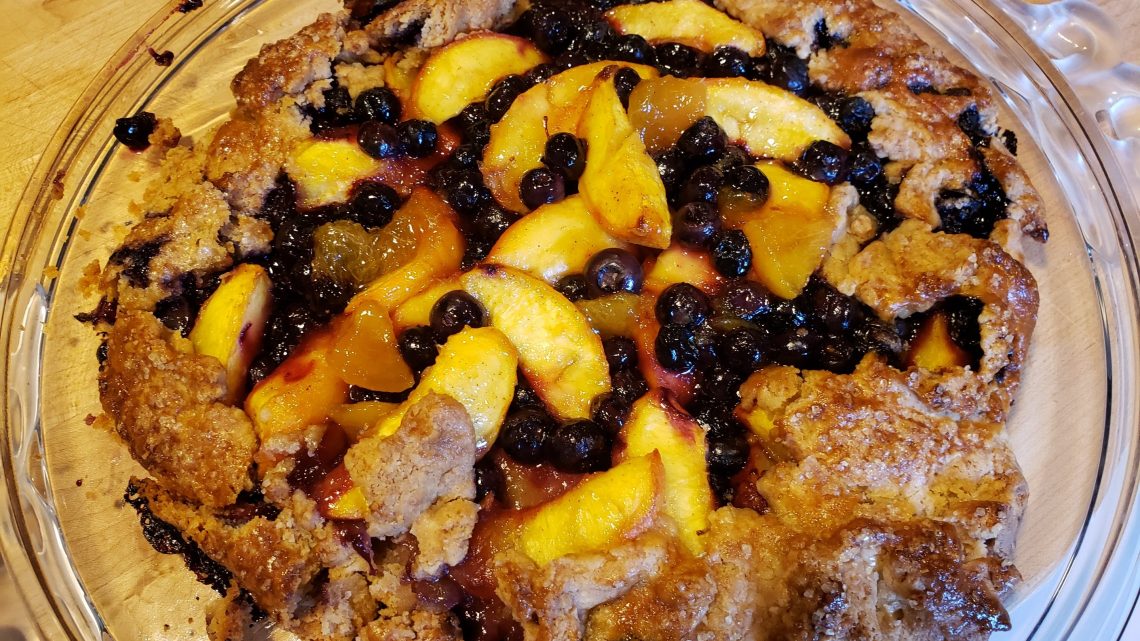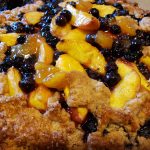Is a galette a pie for a lazy baker? I don’t really think there’s such a thing as a lazy baker, but a galette is among the easiest ways to bake plentiful summer fruits into a crowd-pleasing dessert.
Simple or not, when you encounter pastry filled with juicy peaches, blueberries, plums, strawberries, rhubarb or sliced fall apples, the temptation to dig in is overwhelming.
Almost everything written about galettes includes the word rustic. There aren’t many rules; just about anything goes. At its essence, a galette is pastry dough rolled flat and piled with fruit (or other fillings). An inch or two of the crust is folded back over the filling to form an edge. That’s it.
The filling, whatever it may be, shines bright in the open circle of crust.
It doesn’t have to be pretty, although the golden-brown crust and colorful fruit is hard to resist. There is no standard size or shape. Galettes are free-form: round, oval, or somewhere in-between. I’ve even seen square galettes, but that’s getting a little fancy, betraying the true nature of the dish.
 Stone fruits are among the best fillings. Although plentiful now, the season will be over soon, so don’t delay. Peaches make a great galette. Skin-on or peeled, they can be tossed with cinnamon or ginger and presented carefully arranged in a pattern, or dumped loosely on the crust. Pitted plums or cherries mix well with peaches. Berries, either blue or rasp, add color, texture, and flavor.
Stone fruits are among the best fillings. Although plentiful now, the season will be over soon, so don’t delay. Peaches make a great galette. Skin-on or peeled, they can be tossed with cinnamon or ginger and presented carefully arranged in a pattern, or dumped loosely on the crust. Pitted plums or cherries mix well with peaches. Berries, either blue or rasp, add color, texture, and flavor.
In the fall, apples are a natural to fill a galette. If there’s a fruit grower at your farmers market, ask them for a mix of apples that will add flavor and complexity to the finished product. Woodland Farm at the New Canaan Farmers Market is my favorite source. The usual apple pie spices are welcome here.
 Care must be taken to keep the filling from getting too juicy — the crust can leak creating a flood. Most recipes call for some flour or cornstarch to soak up the juice, but with the variation in ripeness it can be hard to get this just right. Brushing the pastry with jam before adding the fruit can help to seal it.
Care must be taken to keep the filling from getting too juicy — the crust can leak creating a flood. Most recipes call for some flour or cornstarch to soak up the juice, but with the variation in ripeness it can be hard to get this just right. Brushing the pastry with jam before adding the fruit can help to seal it.
I recently made a peach-blueberry galette with Woodland Farm South Glastonbury peaches and farm-stand berries. Scalded in boiling water and peeled, the peaches were very juicy. A quick rinse of the berries may not have been given quite enough time to dry. Even when using a slotted spoon to drain some liquid, the mix was still very juicy and leaked all over the pan while baking. Oh well.
The crust is the key. A standard pastry dough like the one at finecooking.com works well and is easily made in the food processor. Flour, sugar, salt, cold butter, and a little ice water is all you need. The trick is how much water; all the recipes give a range. It depends on humidity, your flour, and the butter. The dough should hold together (just barely), but too much water can make it tough.
I’ll confess it takes a little practice making the pastry to feel really comfortable. The answer, I think, is to make a galette every week until complete confidence is achieved.
Herbs or poppy seeds can be added to the crust. Swap some cornmeal for flour to alter the texture. For my peach-blueberry effort, I used a recipe from Bon Appetit that replaced some of the flour with pulverized graham crackers. It was yummy, but the crust was so short and tender that it was hard to work with and broke when I lifted it off the cooking pan. I think I’ll stick to standard pastry from now on.
I saw a recipe in the June 2021 issue of Southern Living magazine that used a store-bought pie crust (Pillsbury was recommended). They eat well down south and the magazine is a reliable source for good recipes, so I won’t say no to this if you’re stuck. But I’m sure a scratch crust would be flakier and more flavorful. You could also try frozen puff pastry, which might be a better idea.
Baking a galette isn’t for lazy cooks. It’s for contemporary, innovative, cut-the-fuss-and-get-to-the-good-stuff cooks.













No Comment